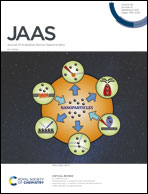Application of saturation absorption spectroscopy to study the hyperfine structure of 235U and accurate 235U/238U isotope ratio determinations at 861.031 nm
Abstract
The uranium transition 5f36d7s2 (5L6) → 5f37s27p (5K5) at 861.031 nm was studied using saturation absorption spectroscopy. The hyperfine structure of the 235U isotope was determined by measuring the Doppler-suppressed absorption spectrum, and the hyperfine structure constants were obtained by employing transition-specific line strength theory and spectral fitting. The magnetic-dipole and electric-quadrupole constants were determined to be A = −3.2887 ± 0.1957 mK and B = 31.8712 ± 8.0789 mK for the upper state 5f37s27p (5K5). A theoretical calculation for the hyperfine structure constants of the 235U isotope was also carried out by the relativistic configuration-interaction (RCI) method, and the obtained values were found to be in agreement with the measured values. In addition, the line profile of 238U was experimentally investigated for different excitation intensities and modeled using the RCI method for estimating the transition probability and oscillator strength, with various residual broadening mechanisms considered beyond the radiative decay. We show that these results allow us to make improvements on the precision of spectral measurements using our previously developed technique for isotope ratio determinations in atomic beams.



 Please wait while we load your content...
Please wait while we load your content...